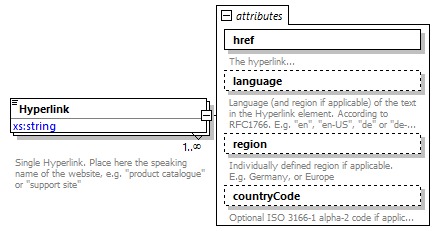| diagram |  |
||
| children | Hyperlink | ||
| used by |
|
||
| annotation |
|
||
| source | <xs:complexType name="Hyperlinks"> <xs:annotation> <xs:documentation>Definition of website hyperlinks. Translatable and regionalisable. Place the speaking name of the Hyperlink inside the Hyperlink element and the url itself inside the href attribute. Define language, region and/or country code attributes, if applicable. To get a fine-grained definition like: Suport site, in english, for european customers</xs:documentation> </xs:annotation> <xs:sequence> <xs:element name="Hyperlink" maxOccurs="unbounded"> <xs:annotation> <xs:documentation>Single Hyperlink. Place here the speaking name of the website, e.g. "product catalogue" or "support site"</xs:documentation> </xs:annotation> <xs:complexType> <xs:simpleContent> <xs:extension base="xs:string"> <xs:attribute name="href" type="xs:string" use="required"> <xs:annotation> <xs:documentation>The hyperlink url</xs:documentation> </xs:annotation> </xs:attribute> <xs:attribute name="language" type="xs:language"> <xs:annotation> <xs:documentation>Language (and region if applicable) of the text in the Hyperlink element. According to RFC1766. E.g. "en", "en-US", "de" or "de-DE"</xs:documentation> </xs:annotation> </xs:attribute> <xs:attribute name="region" type="xs:string"> <xs:annotation> <xs:documentation>Individually defined region if applicable. E.g. Germany, or Europe</xs:documentation> </xs:annotation> </xs:attribute> <xs:attribute name="countryCode"> <xs:annotation> <xs:documentation>Optional ISO 3166-1 alpha-2 code if applicable</xs:documentation> </xs:annotation> <xs:simpleType> <xs:restriction base="xs:string"> <xs:pattern value="[a-zA-Z]{2}"/> </xs:restriction> </xs:simpleType> </xs:attribute> </xs:extension> </xs:simpleContent> </xs:complexType> </xs:element> </xs:sequence> </xs:complexType> |
element Hyperlinks/Hyperlink
| diagram |  |
||||||||||||||||||||||||||||||||||||||
| type | extension of xs:string | ||||||||||||||||||||||||||||||||||||||
| properties |
|
||||||||||||||||||||||||||||||||||||||
| attributes |
|
||||||||||||||||||||||||||||||||||||||
| annotation |
|
||||||||||||||||||||||||||||||||||||||
| source | <xs:element name="Hyperlink" maxOccurs="unbounded"> <xs:annotation> <xs:documentation>Single Hyperlink. Place here the speaking name of the website, e.g. "product catalogue" or "support site"</xs:documentation> </xs:annotation> <xs:complexType> <xs:simpleContent> <xs:extension base="xs:string"> <xs:attribute name="href" type="xs:string" use="required"> <xs:annotation> <xs:documentation>The hyperlink url</xs:documentation> </xs:annotation> </xs:attribute> <xs:attribute name="language" type="xs:language"> <xs:annotation> <xs:documentation>Language (and region if applicable) of the text in the Hyperlink element. According to RFC1766. E.g. "en", "en-US", "de" or "de-DE"</xs:documentation> </xs:annotation> </xs:attribute> <xs:attribute name="region" type="xs:string"> <xs:annotation> <xs:documentation>Individually defined region if applicable. E.g. Germany, or Europe</xs:documentation> </xs:annotation> </xs:attribute> <xs:attribute name="countryCode"> <xs:annotation> <xs:documentation>Optional ISO 3166-1 alpha-2 code if applicable</xs:documentation> </xs:annotation> <xs:simpleType> <xs:restriction base="xs:string"> <xs:pattern value="[a-zA-Z]{2}"/> </xs:restriction> </xs:simpleType> </xs:attribute> </xs:extension> </xs:simpleContent> </xs:complexType> </xs:element> |
attribute Hyperlinks/Hyperlink/@href
| type | xs:string | ||
| properties |
|
||
| annotation |
|
||
| source | <xs:attribute name="href" type="xs:string" use="required"> <xs:annotation> <xs:documentation>The hyperlink url</xs:documentation> </xs:annotation> </xs:attribute> |
attribute Hyperlinks/Hyperlink/@language
| type | xs:language | ||
| annotation |
|
||
| source | <xs:attribute name="language" type="xs:language"> <xs:annotation> <xs:documentation>Language (and region if applicable) of the text in the Hyperlink element. According to RFC1766. E.g. "en", "en-US", "de" or "de-DE"</xs:documentation> </xs:annotation> </xs:attribute> |
attribute Hyperlinks/Hyperlink/@region
| type | xs:string | ||
| annotation |
|
||
| source | <xs:attribute name="region" type="xs:string"> <xs:annotation> <xs:documentation>Individually defined region if applicable. E.g. Germany, or Europe</xs:documentation> </xs:annotation> </xs:attribute> |
attribute Hyperlinks/Hyperlink/@countryCode
| type | restriction of xs:string | ||||||
| facets |
|
||||||
| annotation |
|
||||||
| source | <xs:attribute name="countryCode"> <xs:annotation> <xs:documentation>Optional ISO 3166-1 alpha-2 code if applicable</xs:documentation> </xs:annotation> <xs:simpleType> <xs:restriction base="xs:string"> <xs:pattern value="[a-zA-Z]{2}"/> </xs:restriction> </xs:simpleType> </xs:attribute> |
XML Schema documentation generated by XMLSpy Schema Editor http://www.altova.com/xmlspy